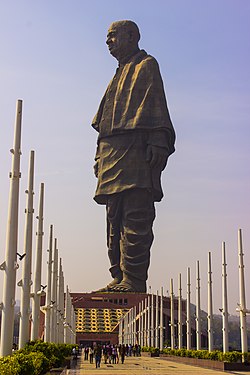World's Biggest Statue in India
Statue of Unity
The Statue of Unity is the world's tallest statue, with a height of 182 metres (597 feet), located near Kevadia in the state of Gujarat, India. It depicts Indian statesman and independence activist Vallabhbhai Patel (1875–1950), who was the first deputy prime minister and home minister of independent India and an adherent of Mahatma Gandhi. Patel is highly respected for his leadership in uniting 562 princely states of India to form the single Union of India. The statue is located in Gujarat on the Narmada River in the Kevadiya colony, facing the Sardar Sarovar Dam 100 kilometres (62 mi) southeast of the city of Vadodara.
Statue of Unity
The project was first announced in 2010, and construction started in October 2013 by Indian company Larsen & Toubro, with a total construction cost of ₹27 billion (US$422 million).[5] It was designed by Indian sculptor Ram V. Sutar and was inaugurated by the Prime Minister of India, Narendra Modi, on 31 October 2018, the 143rd anniversary of Patel's birth.
History Of Statue :
Narendra Modi announced the project on 7 October 2013 to mark the beginning of his tenth year as the chief minister of Gujarat.[7]
A society named Sardar Vallabhbhai Patel Rashtriya Ekta Trust (SVPRET) was formed under the chairmanship of the Chief Minister of Gujarat, to execute the project.[7][8]
Statue of Unity Movement was started in 2013 to collect the iron needed for the statue by asking farmers to donate their used farming instruments. By 2016, a total of 135 metric tonnes of scrap iron had been collected and about 109 tonnes of it was used to make the foundation of the statue after processing. A marathon titled Run For Unity was held on 15 December 2013 in Surat and Vadodara in support of the project.
Design and Construction details :
Design
 The Statue of Unity is an enlarged version of this statue in the Ahmedabad International Airport
The Statue of Unity is an enlarged version of this statue in the Ahmedabad International Airport
After studying statues of Patel across the country, a team of historians, artists, and academics chose a design submitted by the Indian sculptor Ram V. Sutar.[a] The Statue of Unity is a larger version of a statue of the leader installed at Ahmedabad International Airport. Commenting on the design, Ram Sutar's son, Anil Sutar explains that, "the expression, posture and pose justify the dignity, confidence, iron will as well as kindness that his personality exudes. The head is up, a shawl flung from shoulders and hands are on the side as if he is set to walk". Three models of the design measuring 3 feet (0.91 m), 18 feet (5.5 m), and 30 feet (9.1 m) were initially created. Once the design of the largest model was approved, a detailed 3D-scan was produced which formed the basis for the bronze cladding cast in a foundry in China.
Patel's dhoti-clad legs and the use of sandals for footwear rendered the design thinner at the base than at the top thereby affecting its stability. This was addressed by maintaining a slenderness ratio of 16:19 rather than the customary 8:14 ratio of other tall buildings. The statue is built to withstand winds of up to 180 kilometres per hour (110 mph) and earthquakes measuring 6.5 on the Richter scale which are at a depth of 10 km and within a radius of 12 km of the statue. This is aided by the use of two 250 tonne tuned mass dampers ensuring maximum stability.
The total height of the structure is 240 m (790 ft), with a base of 58 m (190 ft) and the statue measuring 182 m (597 ft). The height of 182 metres was specifically chosen to match the number of seats in the Gujarat Legislative Assembly
Features
 Prime Minister Narendra Modi in the museum within the complex
Prime Minister Narendra Modi in the museum within the complex
The Statue of Unity is the world's tallest statue at 182 metres (597 ft). It rises 54 metres (177 ft) higher than the previous record holder, the Spring Temple Buddha in China's Henan province.[37] The previous tallest statue in India was the 41 m (135 ft) tall statue of Lord Hanuman at the Paritala Anjaneya Temple near Vijayawada in the state of Andhra Pradesh. The statue can be seen within a 7 km (4.3 mi) radius.
The monument is constructed on a river island named Sadhu Bet, 3.2 km (2.0 mi) away from and facing the Narmada Dam downstream.The statue and its surroundings occupy more than 2 hectares (4.9 acres), and are surrounded by a 12 km (7.5 mi) long artificial lake formed by the Garudeshwar weir downstream on the Narmada river.
The statue is divided into five zones of which only three are accessible to the public. From its base to the level of Patel's shins is the first zone which has three levels and includes the exhibition area, mezzanine and roof. The first zone also contains a memorial garden and a museum. The second zone reaches up to Patel's thighs, while the third extends up to the viewing gallery at a height of 153 metres. The fourth zone is the maintenance area while the final zone comprises the head and shoulders of the statue.
The museum in the first zone catalogues the life of Sardar Patel and his contributions. An adjoining audio-visual gallery provides a 15-minute long presentation on Patel and also describes the tribal culture of the state. The concrete towers which form the statue's legs contain two elevators each. Each lift can carry 26 people at a time to the viewing gallery in just over 30 seconds. The gallery is located at a height of 153 metres (502 ft) and can hold up to 200 people.

































